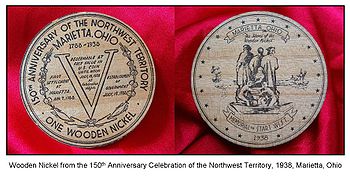
Wooden nickel
Encyclopedia

United States
The United States of America is a federal constitutional republic comprising fifty states and a federal district...
, is a wood token coin
Token coin
In the study of numismatics, tokens are coin-like objects used instead of coins. The field of tokens is part of exonumia. Tokens are used in place of coins and either have a denomination shown or implied by size, color or shape...
, which are usually issued by a merchant or bank as a promotion, sometimes redeemable for a specific item such as a drink. Wooden nickel
Nickel (United States coin)
The nickel is a five-cent coin, representing a unit of currency equaling five hundredths of one United States dollar. A later-produced Canadian nickel five-cent coin was also called by the same name....
s were most commonly issued in the U.S. in the 1930s, after the Great Depression
Great Depression
The Great Depression was a severe worldwide economic depression in the decade preceding World War II. The timing of the Great Depression varied across nations, but in most countries it started in about 1929 and lasted until the late 1930s or early 1940s...
. Wooden nickels can be used as currency.
It was during this decade that some banks and chambers of commerce in the United States issued wooden nickels with expiration dates to mitigate difficulties faced by merchants in making change at times of instability.
Common views published on the Internet concerning the origin of the wooden nickel are patently incomplete, often making it an innovation of this late date that arose in response to such banking difficulties. Commemorative nickels are then supposed to be an outgrowth of these legitimate wooden nickels. However, collectible wooden nickels have been mentioned in print since at least 1888.
In more recent times wooden nickel trading has become more popular. Individuals can have their own personalized token made and then trade with others who also have had their own made. This is especially popular in geocaching
Geocaching
Geocaching is an outdoor sporting activity in which the participants use a Global Positioning System receiver or mobile device and other navigational techniques to hide and seek containers, called "geocaches" or "caches", anywhere in the world....
.
In popular culture
An American adageAdage
An adage is a short but memorable saying which holds some important fact of experience that is considered true by many people, or that has gained some credibility through its long use....
, "Don't take any wooden nickels" is considered a lighthearted reminder to be cautious in one's dealings. This adage, too, precedes the use of wooden nickels as a replacement currency, suggesting that its origins lie not in the genuine monetary value of nickels but rather in their purely commemorative nature. However, such an interpretation should not be altogether ignored: gold-backed currency was in use in the United States until 1933, 90 percent silver coins were still minted until 1964, and 40 percent silver Kennedy half dollars were issued up to 1970.

